Smite interview: Hi-Rez COO Todd Harris on competing MOBAs, F2P economics, and religious sensitivity
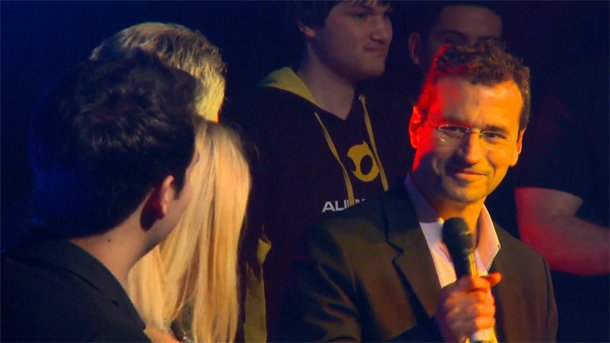
During the three-day launch tournament for Smite , Hi-Rez Studios' actiony third-person MOBA, I met Hi-Rez COO Todd Harris in the crowded halls of Atlanta's Center Stage Theater. When I found him, Harris was busy corralling a group of popular Youtubers into teams to face off in a just-for-fun showmatch before Sunday's grand finals. As Harris and I headed out of the hallway to find a quiet place to chat, fans kept stopping him, shaking his hand and asking for a card with an exclusive launch tournament skin. I thought it was a little odd, at first, that a COO would be so well-recognized. But Harris is a regular fixture of Hi-Rez's YouTube comedy series . He seems happy to make himself look silly on camera. After the grand finals, he'll get up on stage and proudly proclaim that while Smite isn't the number one MOBA, it is the third biggest. He grins as he briefly chants "Number three!" into the microphone.
When we escaped the crowds, we headed up to a VIP area still bearing the scars of Saturday night's launch party. A security guard asked to see Harris's badge. Shouldn't they recognize you, I asked? "They usually do. He must be new!" Harris joked. Once we finally sat down to talk, Harris spoke candidly about the religious sensitivity around Smite, the game's profitability, and Hi-Rez's plans for future gods.
PC Gamer: Can you give me an overview of Smite from when you guys started it—two years ago?—to Smite as it is today launching out of beta.
Todd Harris: Three years ago, actually, beginning of 2011, we started experimenting with a new mode of Global Agenda . That was our first game, an MMO shooter. We took the assets from Global Agenda and started playing with a tower defense sort of game. We weren't thinking MOBA. [The MOBA genre] wasn't the explosion it is today.
We played that game, and it was really fun. It was so fun that we thought that this could be its own game. Global Agenda didn't necessarily needs another game mode. So the team said, all right, we'll make it its own game. And as long as its its own game, what IP should we use? The science fiction setting we thought didn't work as well for that tower defense sort of game.
PCG: As opposed to something more fantasy or classical?
Harris: Exactly. Mainly because of weapon differences. We wanted to work with spells instead of guns, where people expect to be able to take someone out at a distance. And that wasn't the pacing and distance of engagement that seemed to make sense for the type of game we were starting to head to.
The biggest gaming news, reviews and hardware deals
Keep up to date with the most important stories and the best deals, as picked by the PC Gamer team.
So we switched to a fantasy setting. [Hi-Rez co-founder] Erez and his notebook, which has a thousand ideas at all times, one of them said make a gods vs. gods game at some point. We were like, well, this is the time to do it.
It was also a pretty big risk slash bet. We'd spent all this time on these Global Agenda assets and IP, and we could just move that over and have the game out more quickly. But we said this is really going to be a stronger game—ultimately it will resonate more with players around the world. The team was super excited about the theme, our character modelers and animators.
We switched to gods and goddesses and quickly had a roster of 10 gods, ish. [The game was] a little more simplistic at the beginning. We didn't fully embrace the 3D space. There were more traditional cone attacks and area of effect attacks. But it was always behind the back. Because our DNA is an Unreal 3 action game developer, Global Agenda was third-person behind-the-back, Tribes was a first-person shooter, that action game experience is in our DNA as a developer.
As the game development started to have its own personality, the idea of really embracing the 3D space started to show up specifically with mechanics like being able to gank from above or attack from above like Thor.
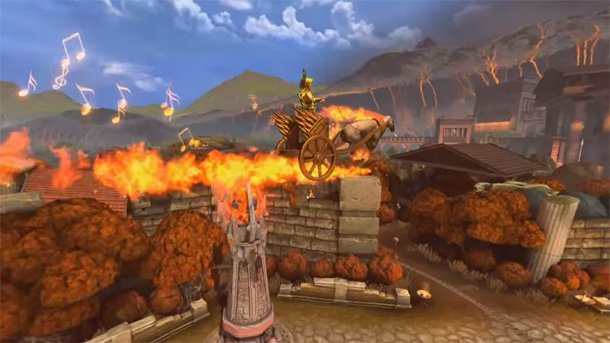
PCG: Like Zapman ...
Harris: Like Zapman did over and over with Apollo, to escape, or to come crashing in, or to escape and then come crashing back in. So, yeah. We took the game and showed it at both PAXs and had a really good reception and continued to put more and more people on it. I mean, our beta process was close to two years.
PCG: That's a long beta. That's like a Google beta.
Harris: It is, yeah. But the game continued to grow. For us it wasn't important that it suddenly has this huge influx. We just steadily wanted to see more people being able to discover the game and be willing to try it even in a beta state. And it continued to get better. And it changed a lot.
From early beta to now, if you look at the characters and the maps and the UI, it's just night and day in a number of aspects. From a design standpoint, our Conquest, which is our traditional three lane map—we've experimented with a lot of designs. We had jungles on the sides at one point. We had a more complex path through the jungle at one point. But they ended up being elements that we didn't think add to the game. This confused users ultimately, and didn't enhance the core things we were trying to do with the game.
And then aesthetically we've improved the game a lot. The artists have been hard at work. Every one of our modes really has a completely different art set from when we began in beta. And same with characters. We took a lot of characters that were already done and we redid them because the graphics weren't good enough.
PCG: So you had to do a lot of original art work to begin with when you switched over to this new style. Did you have a lot of engine tech you could bring over from Global Agenda to make that side of things easier?
Harris: We had a lot of experience with the tools. So there weren't a starting library of art assets, but our artists had been working with the modeling tools and specifically creating assets and lighting techniques and maps specific to Unreal 3 across three games and seven years of experience at that time. So that experience allowed them to do higher quality work more quickly.
And we had a lot of tech. A lot of what we spent time on was technology that lets us make a game design change and test it very quickly because we're a very iterative studio. The designers come up with what they think will be fun but then we actually playtest it every day and a lot of things end up changing. In order to not drive yourself too crazy, you want tools that let you do that. So the tools and the experience definitely helped us, and continue to help us, put out content that's good quality. And pretty quickly, also.
PCG: Are there any examples you can think of in terms of that iterative process that's really changed?
Harris: One of the biggest, this is a character one—we do talk about this a lot, but it's an interesting one—the original Sun Wukong that we did in the game, we looked at classical treatments of Sun Wukong and the team tried to research it, but the team came up with a character that is somewhat authentic to some early treatments, but not at all relevant to current Chinese understanding and depiction of Sun Wukong.
PCG: And that's a character that's been in so many...things.
Harris: So many games and movies, yeah. He's in pop culture. So we definitely missed the mark there. We took that character, previously known as Sun Wukong, changed his look and kit a little bit but preserved the same playstyle because people definitely liked it, and he got rebranded as Hun Batz, who's a Mayan monkey god. And it took us a long time to come out with a new Son Wukong that's very authentic and matches what people like. And he's a very popular character. That's an extreme example of iterating, or really replacing.
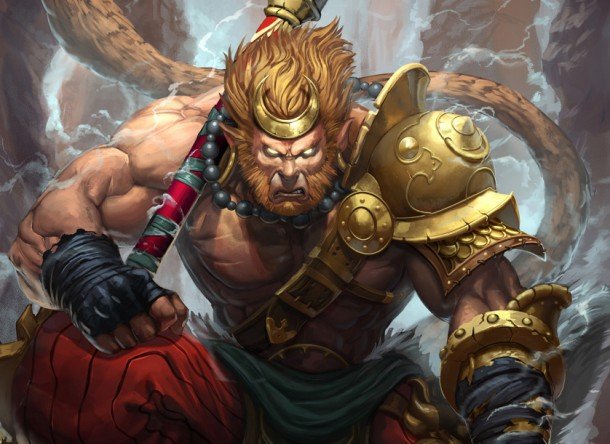
PCG: There's a real difficulty with dealing with characters like that, when all your characters are pulled from mythology or religion. It's really easy to offend somebody, or to just have to be really careful. What has the process of choosing which gods are in the game been like, and choosing what they'll look like, and how they'll play in a video game?
Harris: It's true, it can be a sensitive topic. For us, we wanted to start with a set number of pantheons, meaning families of mythology. So rather than just picking randomly or from the broadest number of gods out there, we wanted to give them families. So we looked across and tried to identify a few that were popular enough, or known enough, and had a wide array of gods that were historically depicted in combat.
That was our high level qualification. Okay, if they're traditionally depicted in combat, it kind of makes sense we could put them in this battleground of the gods. And that's where we came up with the families that we chose, which is basically Greek, Roman, Norse, Egyptian, Chinese, Hindu. And there has been sensitivity. We were in the press a lot specifically around our depiction of Kali, a Hindu goddess, who is actively worshipped today. The Chinese deities are also very actively worshipped in some parts, but it's just a different perspective and they're not criticized. In fact, that market wants more and more of them depicted.
So really, the Hindu example has been the most prominent case of really one individual leading a charge and creating some press. But ultimately we wanted to stay authentic to our vision of the game. And the reality is, I think, it doesn't really matter—the people that are upset about that would not be playing our game. And we get, actually, many more emails from people that say they're Hindu and they're very excited to see that their gods are in the game.
PCG: Religion is obviously something you guys had to be careful about, but what about the goddesses in the game? The character art is fantastic, but every goddess in the game is extremely voluptuous and not many of them have clothes on. And that's something that the industry at large has been talking about more and more in games recently—the depiction of female characters, being sensitive to that being a male power fantasy thing. Is that something you talk about at the studio?
Harris: It's something we talk about. For good or for bad, and this is not an excuse for it, the reference images we look at for most of these goddesses are much less clothed and more voluptuous than you see them in Smite. It's not an excuse, necessarily, but it is the reference image folks are going by when they reference Aphrodite or Niethe. But I personally do think it's important to show diversity in terms of body types for both sexes and I think over time you'll see more of that.
We do [already] have cases of, like, Artemis, who's more tomboyish, and that's her character. There's Chang'e, who's covered up, a little more demure, which also fits her character ( update : I misheard Ne Zha for Chang'e, who is a male God. Thanks for Todd for the correction -ed.). With Athena, we got some criticism, and probably rightly. One of the cards was a little more sexy than she needs to be, and some of the skins are, but her base is a little more warrior. I think you'll see more diversity, and it's a valid topic to talk about, definitely.
PCG: Going forward, are you going to expand the pantheons you have, or are there plans brewing for new pantheons?
Harris: Both. For this year it's mainly about rounding out the pantheons that we have. As we look at, say, roughly the following year of 2015, we want to expand the pantheons and particularly as we take Smite into new territories it makes sense.
We're in North America and Europe. Already we're working on China gods. That's the next territory of focus for us. But as we move into other territories, which we still have to lay out that roadmap, but say we expand into Latin America, where there are a lot of interesting things we could draw on from Brazil and other territories.
PCG: Like the Incans and Aztecs?
Harris: Exactly. We have Mayan now, but we could go a little south. Once we approach that we will potentially just pick, rather than doing a whole pantheon, we may just look at offering one or two per regions just so that those areas can be connected and see themselves represented.
PCG: Are there any gods you really want to see in the game?
Harris: Oh, there's tons. [laughs]
PCG: Like who?
Harris: Well, one that we've kind of hinted is in our short term roadmap is another Egyptian god, Osiris, who's going to be pretty cool I think.
PCG: Like you said earlier, the MOBA space is huge now. What have been the priorities or the tactics for trying to compete with League and Dota and now Heroes of the Storm?
Harris: It wasn't really an original tactic because we started with Global Agenda, right—we didn't think we were going to be competing with them, we were going to make an action game that had tower elements. It ended up being in the MOBA category. Fortunately, we don't really feel that we compete exactly head-to-head on the same things because of the camera angle. Most people who play our game say the combat feels very different. And we tend to see...there's not as many people that play League and Dota, but we have many people that play one of those games and also play Smite, because it's a different kind of experience.
The other thing is that we think we're growing the MOBA market, because we have a lot of FPS players or players of MMO PvP that like the WASD thing, and it's a gateway MOBA for them. They didn't like any other MOBAs because the controls didn't feel comfortable, but they like this. I think that's fortunate, a little bit by accident for us, that we're in that action category as much as the MOBA category, especially now that Blizzard also has a strong entry in the top-down.
I wouldn't be surprised if we see other companies trying to be in that category because they might think, oh, we can take on Smite and not take on Valve, Riot, and now Blizzard. Could happen. Big players there, right? With big budgets.
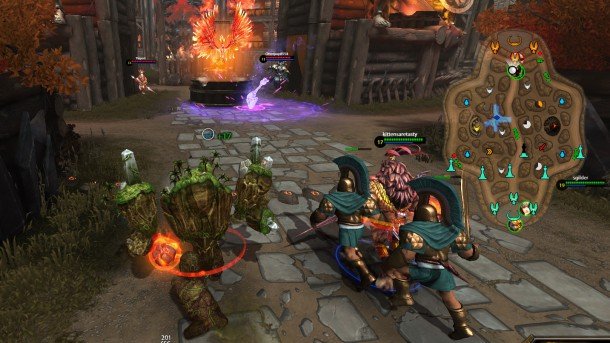
PCG: The spectator mode is really cool. When you were building out your launcher and the technology to go along with it , was that a big part of the plan, making a good spectator sport, having Twitch built into the launcher, stuff like that?
Harris: Yeah, the eSports support was big from the beginning. Again, PVP's a little bit in our DNA. We had that in Global Agenda. Esports were not quite at the level as they are. With Tribes, we had aspirations for that being an eSport. We invested a little in a spectator mode. But Global Agenda was like version one of the platform, Tribes was like version two, and now with Smite, it's like all that learning, plus more tech, we've got version three.
So from the beginning [the plan] was: keep the game balanced so it could be competitive, not have it be pay-to-win or even grind-to-win. We deliberately said we didn't want any out-of-match leveling system like rune pages , anything that would affect your stats. We'd just have something like favor that's only cosmetic at the end of the day. It does give you entry into the league system but doesn't give you any stat bonus. And invest a lot in spectator mode and demos and integrating Twitch and all that.
PCG: That potentially takes away a revenue source for you, right? Not having rune pages or something like that in the game?
Harris: It does. Depends on the game whether it helps or hurts, but it's a progression element that some people certainly enjoy and it is a revenue potential stream. But for us, particularly because there's other games already in the market that people are comparing it to and maybe thinking about switching or getting their friend to switch, the idea that they would not be coming in so far behind...it already takes so much time with these games to learn the characters. If they felt that either they'd have to drop a lot of money, or put in a lot of hours, or both, we wanted to remove that.
So we said all right, no out of match rune page. In fact, let's do this god pack . People can pay $30 and get all the gods in the game and every god we ever release for a one-time price. So if I tell you [the game is] good, and you say you don't want to pay [all that] much, from a competitive standpoint, you don't have to. You can pay once. So we made some decisions like that because there's already games out there and we wanted to be attractive to folks. And also, as gamers, we liked the idea of it being a balanced playing field at the very beginning.
PCG: Was that also partially a response to Tribes? I know there was some criticism over the free to play economy.
Harris: It was less that. There was criticism, as there probably is with every free to play game. In the early days Tribes was pretty grindy, but I think we addressed that. So that particular audience may not have wanted a free to play, but it was less that, more of looking at the MOBA space and what player expectations are within the MOBA space, and trying to basically meet or exceed those.
PCG: Is Smite profitable for you now?
Harris: It is. We've grown our studio from around 50 people around a year and a half ago, to 85-plus, all profitably through Smite, and we're growing very quickly now.
PCG: That's really great, especially for having been in beta that whole time. How long did it take for it to turn a profit?
Harris: If you look at it from just a project basis, it's hard to know, since we had people on other games for awhile and gradually moved them to Smite. Really I would say after the first year, basically, it was profitable from a project standpoint. But it's only more recently that it's been supporting the entire studio.
PCG: With the character roster you've got 50 or 51 gods now. Who are the most played gods and how many gods would you say, at least in competitive play, you're not seeing used very often?
Harris: I think our percentage of the pool that we've seen, even just in these three weekends , is pretty strong. Looking at just the two matches that were played, it looks like a larger percentage of the pool than other MOBAs, currently.
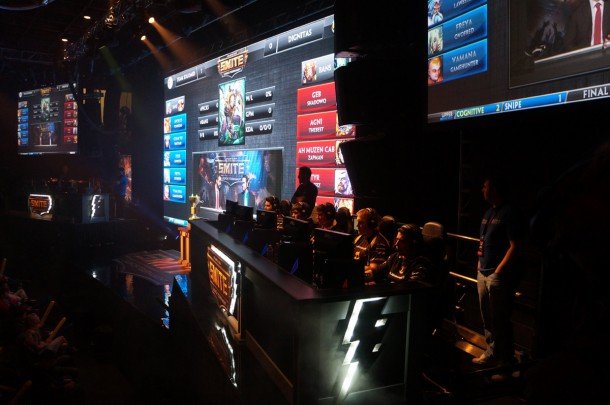
PCG: My eyeball guess would be 20, 25 at the high end.
Harris: I think it'll end up being around 25, probably, which is almost half of them, so that's pretty good. We see, obviously, even a higher percentage played in live. So we're pretty active about that. We do patches every two weeks.
In addition to new content, we're always looking at the play time and the power charts. We'll slow down a little bit, but through beta we were very actively making changes if gods were not popular or were too underpowered in general.
PCG: It's interesting for me to see who gets played in competitive games vs. me just playing casually. The gods that I really liked, and playing against other newcomers, was just wrecking face with, are not the ones played by the pros.
Harris: There's a lot of that. So we look at what's played in tournaments. We also look at the playtime for level 30 players vs. under-30, where there are big differences. And we'll also look at the play patterns for players that are high ELO behind the scenes vs. low. And we have to look at all that because there's very different patterns.
PCG: How do you balance a character that can be used by the pros very effectively but is not used at all at the low levels?
Harris: That's why we hire exceptional designers, and I say balance! [laughs]
No, a lot of it is trying to understand—one of the unique things with Smite is there's the stat balance, and with almost all the gods, there's this skill shot dexterity angle. So the balance team does have to put some factor for that in their balance spreadsheets, right? Because I don't hit my Ra snipes like those guys. I don't evade like Lassiz and Zapman and get out of those things.
PCG: It didn't fully register to me while watching the matches with the spectator mode, but when the pros juke like that, they do it without being able to see things coming. Which is like...how do you do that?
Harris: Our whole studio enjoys watching a lot of the eSports events, and other MOBAs, but one of the things that's unique about Smite is that dodging and evading being such a part of it, and is pretty exciting for the crowd to see those players. Which was intentional, we wanted the game to be quicker to the action, more kills, and a little more ability for that reflex action game element by an individual or a coordinated team to turn the tide.
PCG: Last question. Who's your favorite god to play?
Harris: My favorite is easy. It's Zeus. Just because he was one of the early gods, he's a little OP, I can win with him which means he's a little OP. And he's Zeus. He's the king. He's the main dude.
Thanks to Hi-Rez's Todd Harris for finding time to talk to us during the Smite launch weekend. For more on Smite, check out our 12 favorite plays from the launch tournament.

Wes has been covering games and hardware for more than 10 years, first at tech sites like The Wirecutter and Tested before joining the PC Gamer team in 2014. Wes plays a little bit of everything, but he'll always jump at the chance to cover emulation and Japanese games.
When he's not obsessively optimizing and re-optimizing a tangle of conveyor belts in Satisfactory (it's really becoming a problem), he's probably playing a 20-year-old Final Fantasy or some opaque ASCII roguelike. With a focus on writing and editing features, he seeks out personal stories and in-depth histories from the corners of PC gaming and its niche communities. 50% pizza by volume (deep dish, to be specific).

